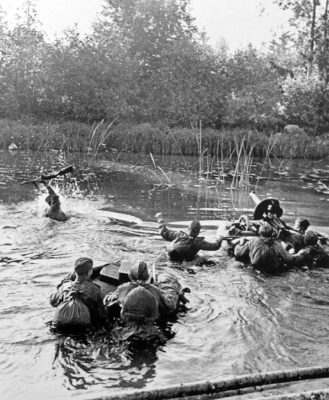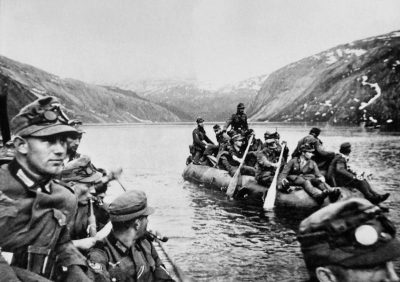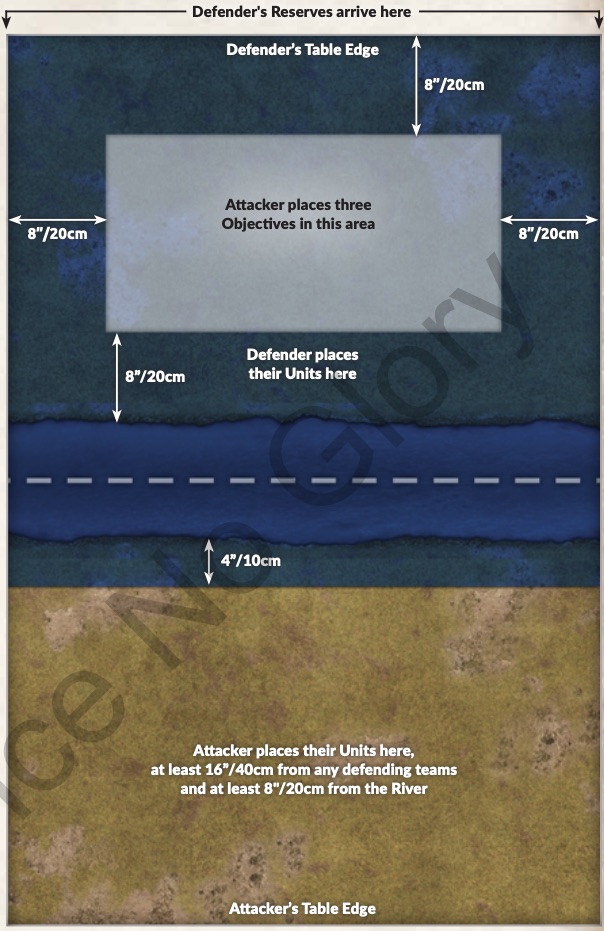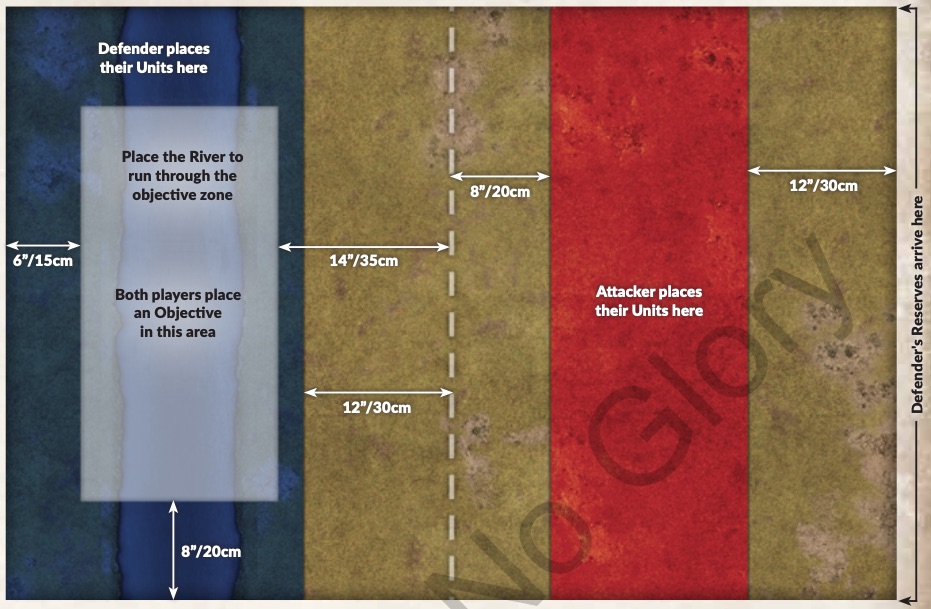FoW Bagration Soviet : Extra missions and mini-campaign
By Tom Gall
With the release of the Bagration Soviet book for Flames of War version 4, you might think this is a book that has no interest to you when you have no Soviet forces. There is some gold at the end of the book that might just change your mind.
The majority of the book is devoted to Late War Soviet forces, true. There are 50 pages of list material to consume.
After that there, several sections of extra material that I think will pique your interest. Remember a key feature of the D-Day series of books for version 4 has been extra missions and mini-campaigns. While I’m sure you’re familiar with the the D-Day books and now Bagration added further missions for you to try your hand at.
In Bagration, the 3 new additions are entitled River Crossing, The Crossroads, and A Foothold. All three are designed around a river which introduces a number of tactical complications for both sides and makes for some really fun games.

While crossing rivers was one of the hurdles the Soviets had to face during the Bagration campaign, it’s a common problem that all sides during the war had to solve in many places across the globe. These scenarios as a result are very appropriate outside of Bagration.
In all three scenarios step 2 of deployment a river is placed by the defender specific to the scenario. You’re going to need a river? Where will you get one? As part of the Bagration product line, there is a new pack called Bagration River Assault Mission Terrain Pack that includes a 12″ by 48″ river as well as a cardboard rail bridge, bridge, and river ford. Additionally in the pack are cardboard assault boats and defenses with cards that you might add to your force.
Another option for a river could be the Battlefield in a Box . A bit smaller, than the mat found within the River Assault pack, but not a bad way to go either for a very nice looking river!
As part of river placement is putting down some number of road bridges, rail bridges or fords. If appropriate objectives may be placed on those crossing points. Plays may decide what types of crossings are available or a table is provided to randomly determine what is available. Bridges are short terrain.
River Crossing
In River Crossing the defender picks the short edge of the table to defend from, with their deployment zone stretching 10″ across the centerline towards the attacker’s side of the table. The river is meant to straddle the centerline and provides the defender with approx 4″ of space on the side closest to the attacker. The defender deploys 60% of their force first.
The defender will need to decide do they risk placing forces on the far side of the river to slow down the attacker or meet the attacker on the far bank.
The attacker places three(!) objectives within the defender’s setup zone which is again on the opposite side of the river.
The attacker deploys all their force and may be as close as 8″ to the river but no closer than 16″ from the defender. If the defender chooses to deploy on the far side of the river closer to the attacker, that pushes back the attacker’s start line.
For the defender to win they just have to keep the attacker more than 8″ away from an objective by the end of turn 6. As the zone for the objectives is meant to be at approx 8″ from the river this means the attacker just needs to be successfully across the river to keep the game going, presuming that they place the objectives closes to the river.
The Crossroads
In this mission, the defender once again picks the short edge of the table. There are two zones for the objectives to be placed. The zone closer to the attacker has one objective that is placed by the defender and the other zone deeper on the defender’s size has 2 objectives placed by the attacker. This deeper zone is where the river runs through.
Complicating matters for the defender is their deep immediate reserves arrive from the back edge. They might need to cross the river in order to be an effective part of the right. You can imagine those cross points will attract artillery.
The attacker set up zone is a 28″ x 24″ box that is no closer than 16″ from the defender’s setup zone.
The game can not be won before the 6th turn which generally means the defender will have received their reinforcements.
The attacker might be very tempted to bum rush up the middle, depending on terrain and other factors this could cost the attacker dearly, and not having the ability to win until turn 6 gives the attacker time to consider their approach.
A Foothold
The last mission in the book gives the defender the choice of which short edge they want to defend. The all-important river goes through the defender setup zone and the area where each player places one objective. The twist is the defender’s reserves come in from behind the attacker. So while the attack must move forward towards the objectives to win the game, any units left behind such as artillery will be vulnerable to attack as the defender’s immediate reserves arrive on the table.
The attacker’s set up zone is a strip 16″ wide, 20″ away from the defender’s setup zone, and 12″ away from the opposite far side.
Putting further pressure on both sides is the fact that objectives are immediately live. The defender must last until turn 6 to have a chance to win presuming they are able to keep the attacker from being within 8″ of an objective at the end of their turn.
This is a mission that might reword an attacker who has a highly mobile force. For the defender, the prospect of going after units typically found in the rear and pointed in the wrong direction is a decided advantage. If the attacker decides to hold back to try to defeat the defender’s reserves first, they lose valuable time getting to the objectives as well as presenting the defender to the temptation to launch a counterattack from the river.
Fun complications for sure!
Mini-campaign
As with other v4 LW books, Bagration Soviet has a ladder campaign of linked games. It’s a series of missions where the results of one game influence the next. With 5 games in the series, this gives you a little more to play for over the course of several game sessions. After all, when not only victory is on the line but positive or negative effects for the next game, you’ll play a bit harder.
The first 3 steps from the campaign are drawn from the new missions in this book. The last two are existing missions (Rearguard and Breakthrough) that you are likely familiar with.
River assault rules
With rivers, you’ll need more ways to get across the water than a ford, or bridges. This is where assault boats come in or more rarely amphibious teams. Infantry and allowed a cross check of 4+ for deep rivers but they may not start the game nor end their movement in the river.

The special River Assaults rules give the attacking player 4 assault boats for every 25 points they are fielding. That is a whopping 16 assault boats for a 100 point game. Only infantry teams can use assault boats and they have a capacity of 3.
For those units which have transport attachments, they must either transport their unit across the river or be sent to the rear. I can see American armored infantry players crinkling their noses at that rule.
Units that arrive at the river are able to utilize assault boats as long as they aren’t in use. To get into the water, your unit leader must begin its movement step next to the river. Pinned units may not enter assault boats. Further, a team must be within 4″ to get into a boat.
Prior to the game, you’ll determine which direction the river is flowing. Once in the water, you’ll roll for how much the boat will drift downstream. 4″-16″. If a unit drifts “off” table, they’ll have to roll a 3+ to come back at the edge where they left. If they fail they keep adding a die per turn until successful. Once you’ve determined the drift you move the boat to the opposite shore and stop until the next turn.
Interestingly units in the water maybe not be shot at by the enemy. I found that curious too.
On the following turn, teams disembark on the far bank. Each boat rolls and on a 3+ may return for more passengers. Failures may attempt again next turn.
Summary
With Bagration Soviet, we have three new missions, a new ladder mini-campaign, and a terrain package for river crossings. It’s a great combo and addition to your Flames of War games.
I personally think the most overlooked parts of the new v4 late war books are all the new missions and campaign possibilities that have been crafted by the Battlefront team. These make for some really fun games. I see a lot of focus on the “competitive” scene for Flames of War and what these books enable, but in doing so you completely miss out on the fun and new challenges these books present through the missions and campaigns.
While a part of me will buy the Bagration Soviet book for the lists since I do play Russians, another part of me is buying this book for where it takes the game with new missions and challenges for an afternoon or evening of gaming.





Gotta admit I’m finding it hard to swallow that “units in the water may not be shot at by the enemy”! ‘Surely’ the rules are referring to teams in the water that are actually passengers on the assault boats, and the assault boats themselves can be hit just like any other passenger transport? Shirley??
Even the Hail Mary rule for 82nd Abn in V3 Market Garden was not so forgiving. Nice overview. Looking forward to the Bagration Book!